We
made the rounds from launcher #1 to #2 and then #3 and crisscrossed the
surface at random peering at the mountainous jumbles of pipes and steel,
tires and appliances, plastic and wood.
|
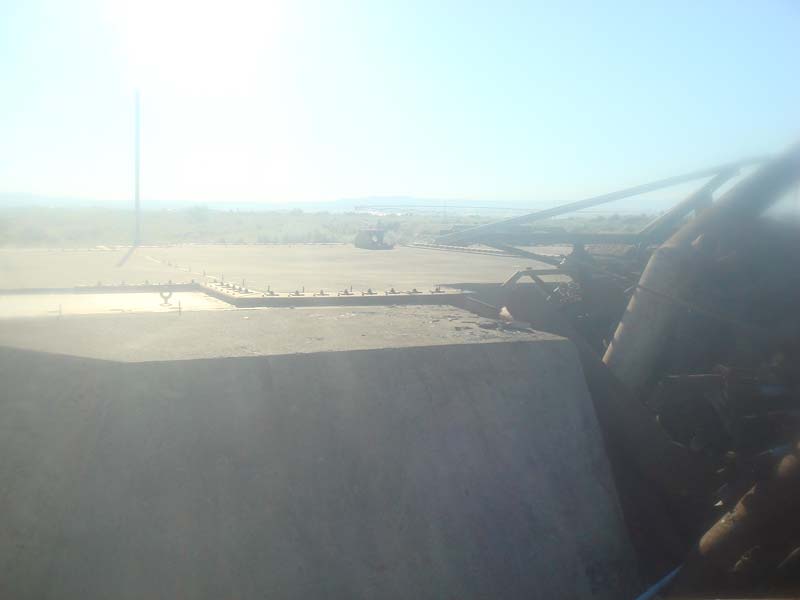
|
|
Another
terrible view of the silo doors, seen through the eyes
of my "dead" camera.
|
|
The
Rift (as the excavation leading down to the launchers became known)
continued to perplex us as we gazed across its ragged span. It
seemed a tremendous effort for which the payoff never arrived, or turned
out to be insubstantial.
|
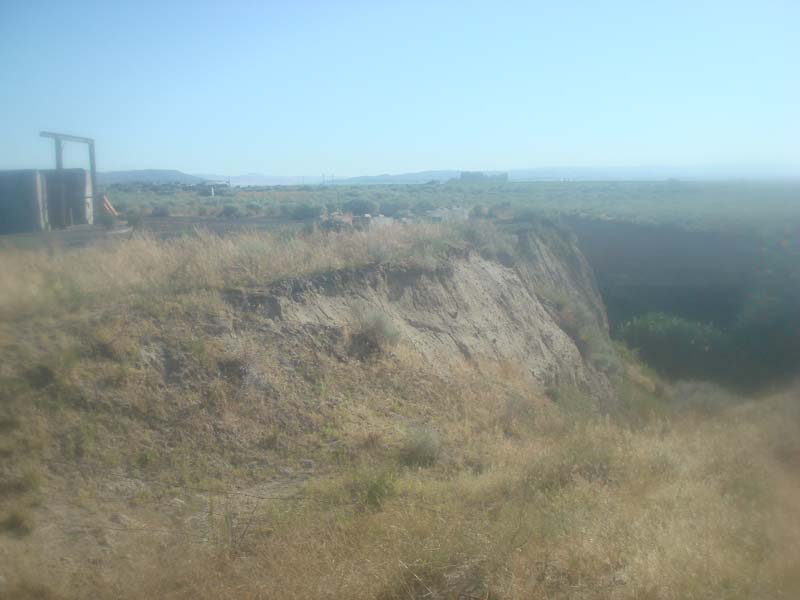
|
|
One
of several excavations on the site. The entry
portal doors are on the left.
|
|
We
volleyed ideas back and forth about the story behind the origins of The
Rift. In the end, shrugs were the prevailing consensus.
|
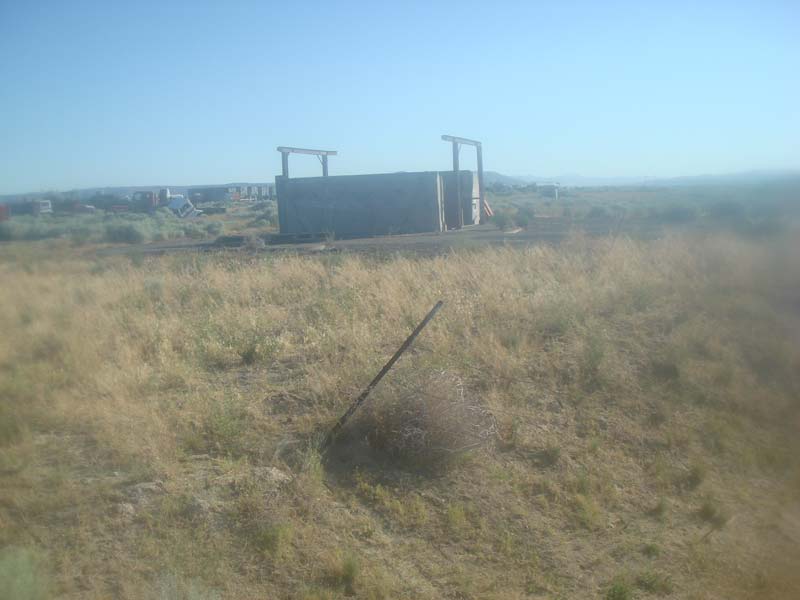
|
|
Entry
portal with junk in the background
|
|
Wandering
toward the entry portal I went back for a closer look. By
this time I'd likely forgotten about my poor camera, seasoned as it was
in silo marinade, it continued to produce a string of unsightly images.
|
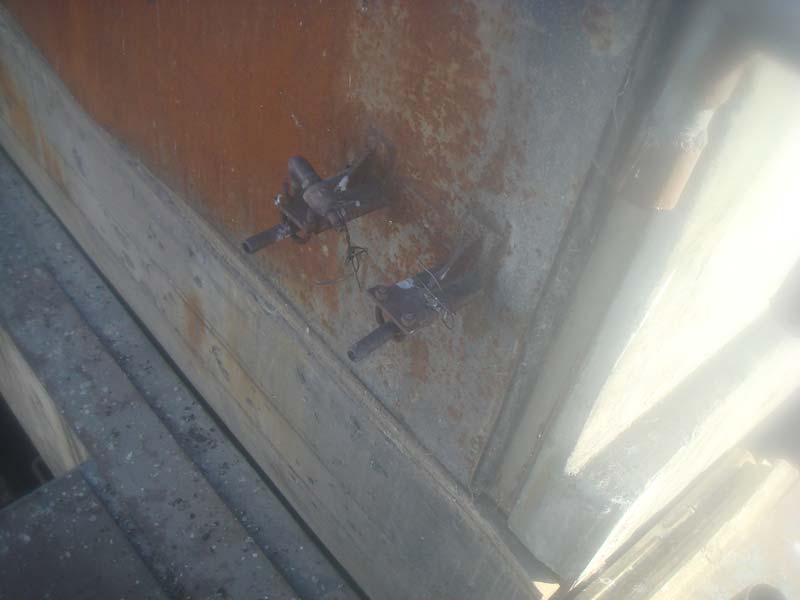
|
|
Supply
and return lines of the integral ethylene glycol heating
system embedded in the entry portal silo doors (flexible
lines absent). This system kept snow and ice from
accumulating and ensured the silo doors didn't freeze
shut.
|
|
These
being the first set of silo doors where I could examine them closely in
the open position, I saw where the snow melt system (see above photo)
ran through the insanely-thick concrete of the doors. There in the
side of the upturned leaf I spied two short lengths of copper protruding
from within the multiple feet of concrete and stunningly-dense mesh of
rebar. You'd have to be dedicated indeed to try to make a go of that
bit of salvage!
|
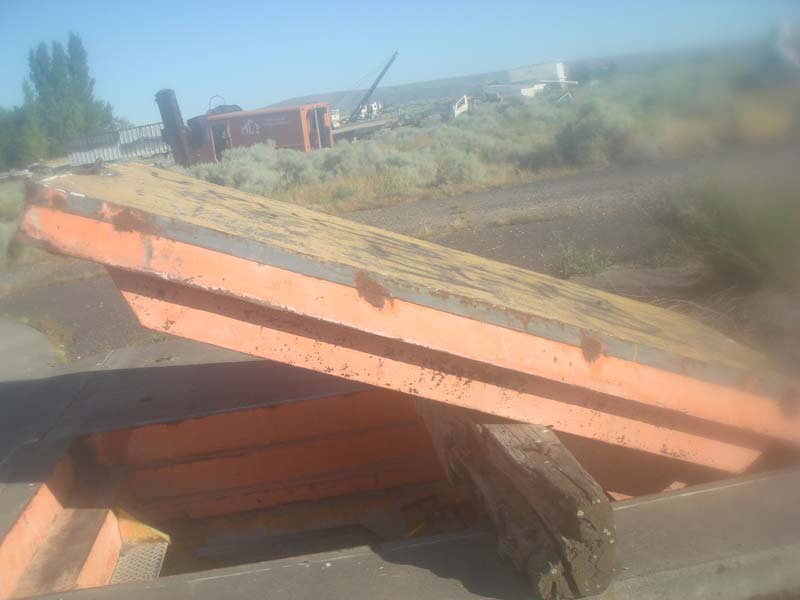
|
|
Personnel
entrance to the entry portal, held open precariously by
a questionable piece of lumber. Sure it looks
sturdy, but it was still a bit unnerving to walk underneath
it.
|
|
Something
large in the distance drew my attention and we walked through the
burr-filled scrub to find the top of the escape shaft we had climbed
earlier down to
reach the flooded launchers.
So
that's where I left that!
|
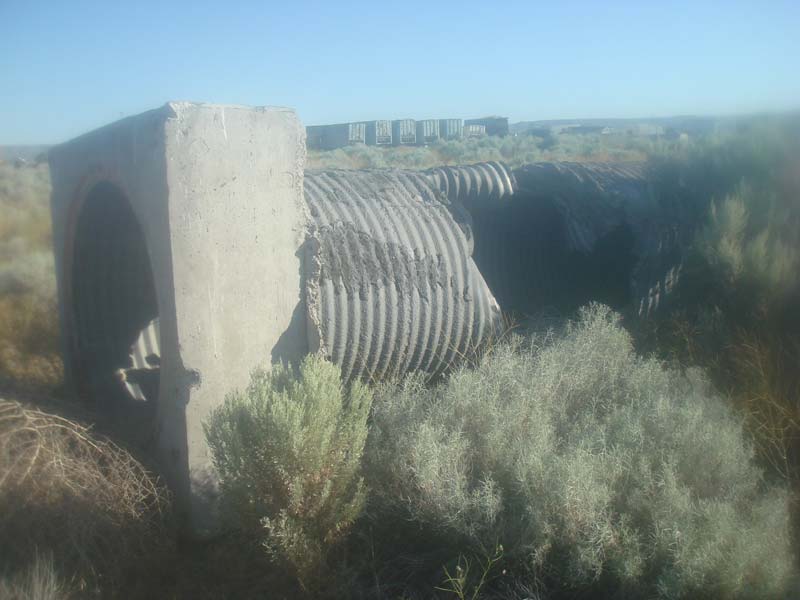
|
|
The very
top of the escape shaft that once led from the ceiling
of blast lock #2. Clearly it has been rather
rudely torn from its former location and deposited
here. Some of the asphalt coating can still be
seen adhering to the exterior of the steel liner.
|
|
After
tearing this section loose, someone had dragged it some distance away to
this spot. I regret not climbing inside it I will
admit.
|
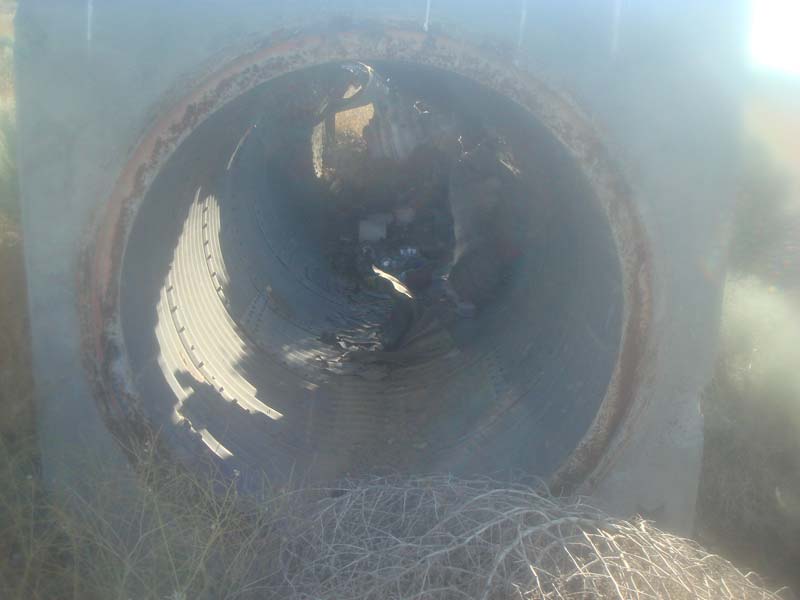
|
|
Looking
through the opening of the severed escape shaft.
No ladder!!
|
|
Another
huge chunk of concrete drew our attention and we found this large vault,
presumably part of the sanitary sewer system or the chemical waste
clarifier system. This concrete box was monolithic, very
thick-walled and had a number of pipes leading into it from several
sides.
Another
likely role for this vault was for electrical runs on the surface.
The ground was riddled with cables for lights, security, communication
and many other services. This box could well have been a
distribution point for many such cables.
|
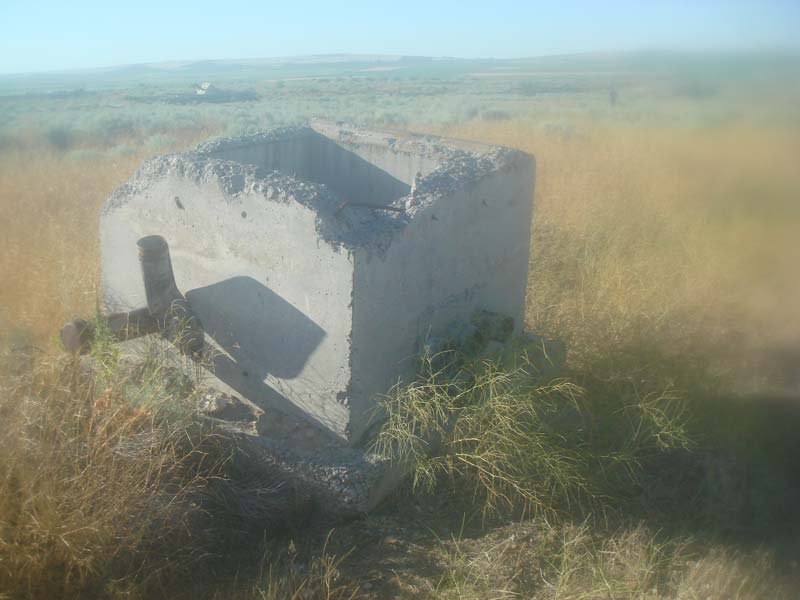
|
|
Believed
to be a part of the sanitary sewer system, this vault
was found excavated somewhere near blast lock #2 and
likely handled waste water from equipment terminal #1 or
served as a junction for all three launchers. It
could also be an electrical cable vault.
|
|
|
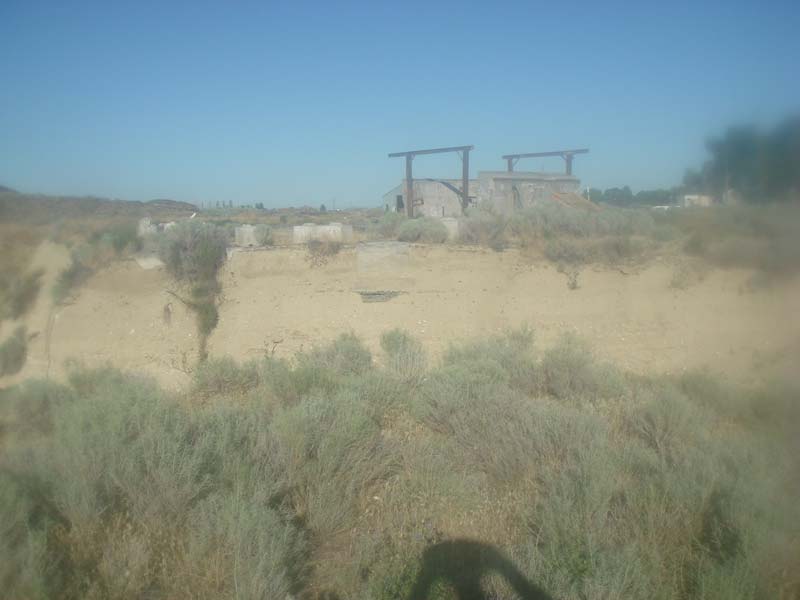
|
|
Another
view across The Rift. Entry portal doors in the
background.
|
|
|
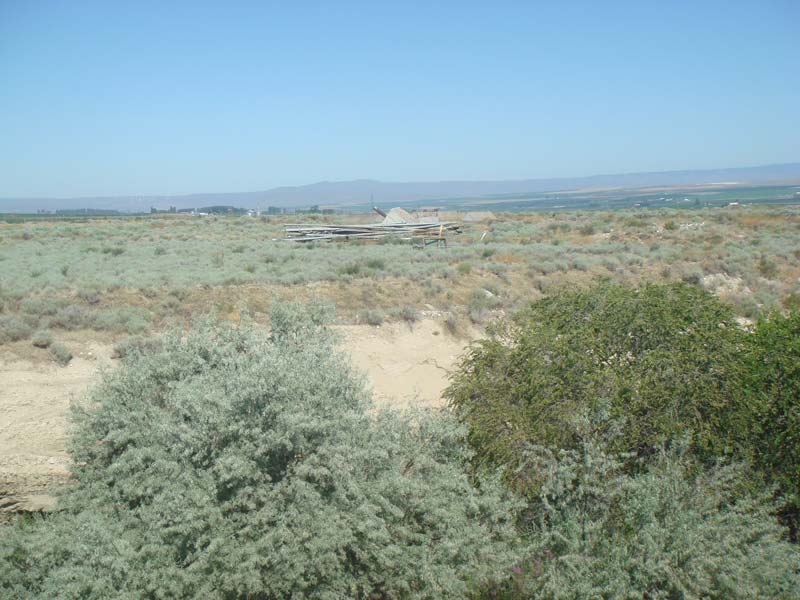
|
|
Looking
across The Rift again, this time at a pile of central
pivot irrigation piping stacked haphazardly next to
another excavated section of concrete that was likely
more of the sewer system.
|
|
|
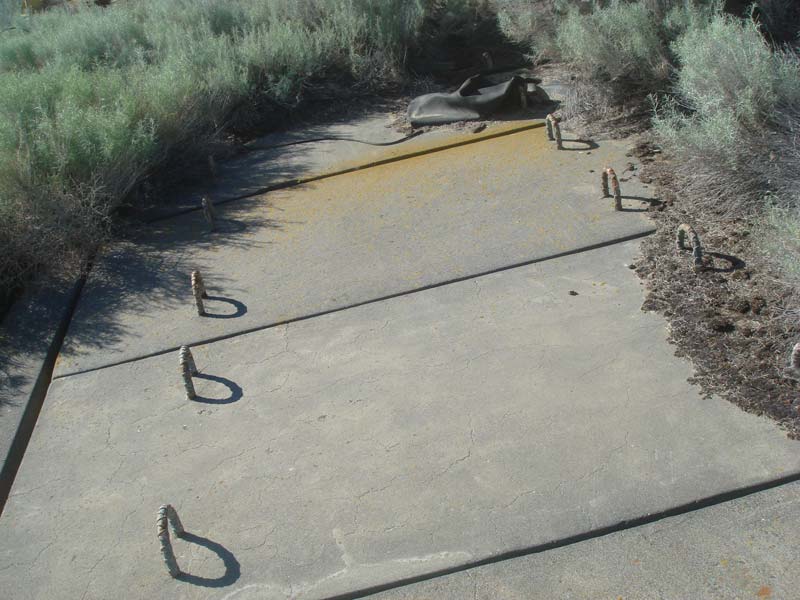
|
|
Top
of the chemical waste clarifier. These concrete
blocks covered the top of a series of chambers filled
with crushed limestone through which waste water would
flow in an effort to filter out contaminants before it
was allowed to flow unimpeded out onto the ground.
Not sure how effective that was; minimal, at best, I
suspect.
|
|
Before
long it occurred to me that we yet had just a few places left in the
underground portion of the complex where we had yet to trundle into
blithely like caricatures of Carter and Canarvon. (regrettably, I
would soon encounter the feared "Titans' Curse" as
you will read later)
There
were in fact three such places remaining and I was determined to see
them all: The power house air intake, exhaust and the launcher area air
filtration facility (LAAFF is not much less a mouthful to annunciate so
why bother?).
The
launcher area air filtration facility is
what supplies the launcher tunnels and blast locks with fresh air and is
basically a miniature version of the power house air intake.
We
found the intake shaft wide open and the ladder still intact so we made
our way down only to find that the pigeons had infiltrated the area,
annexing it as it were, one more part of the world into their giant,
global avian toilet.
|
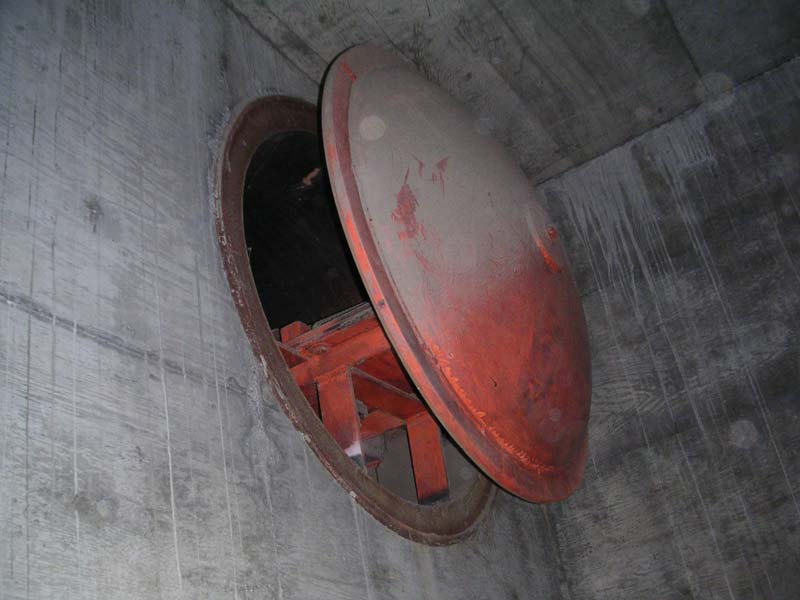
|
|
Largely-intact
blast valve at the launcher air filtration facility
intake.
|
|
At
the bottom of the intake shaft we found one of the blast valves had been
dismantled for access allowing us to just saunter right on
in. Actually, "saunter in" is rather an exaggeration; we
had to lean out to the extreme reach of one arm from a ladder while 10
feet above a concrete floor and extend one foot into the blast valve
opening and then push off from the ladder. On leaving, the reverse
was required, all while avoiding the flapping pigeons and the dreaded
threat of their incontinent overflights as they exploded out of their
hiding places with startling bursts of noise.
|
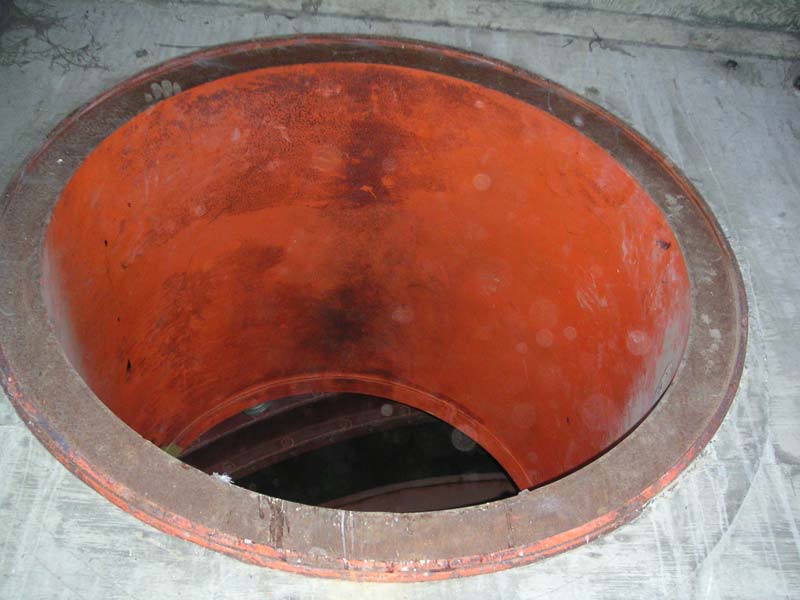
|
|
The
one open blast valve as viewed from the access ladder.
|
|
We
opted to explore the lower filter area first, saving the harrowing and
acrobatic maneuvers needed to reach the upper level for last.
|
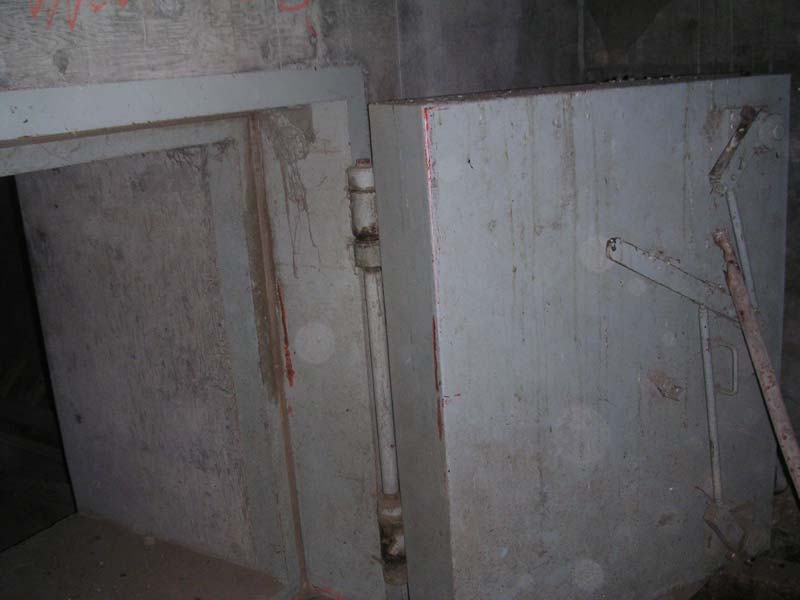
|
|
The
door beyond the blast valves leading into the filtration
area.
|
|
A
substantial, but low blast door (which secured from the inside) was left
conveniently open and through which we accessed the lower level of the
filtration area. There I saw the familiar line of dust collection
hoppers and wondered how the hell they removed the dust from below
ground once they were full!
|
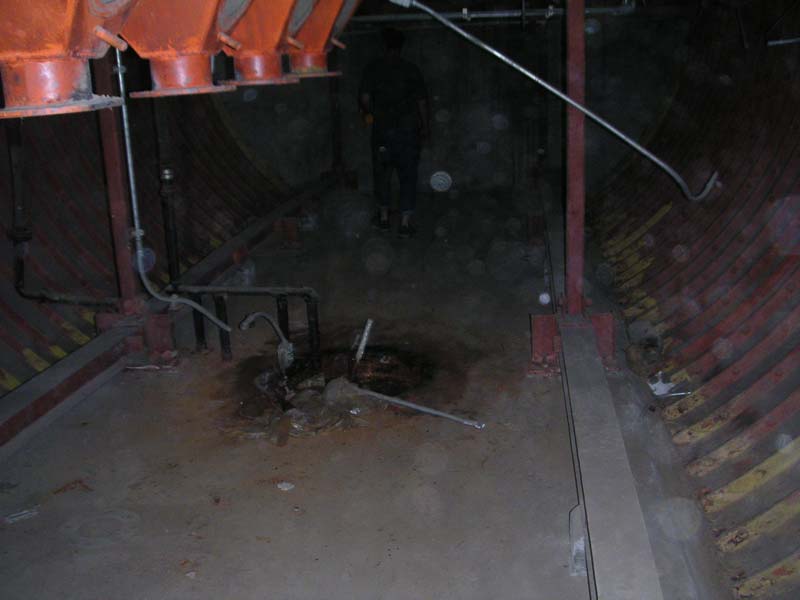
|
|
Dust
collectors (painted orange) in the lower level of the
intake and filtration area.
|
|
These
hoppers were the same at Lowry and other sites and were once connected
to some sort of collection bin or bag where the accumulated dust would
collect and await removal.
|
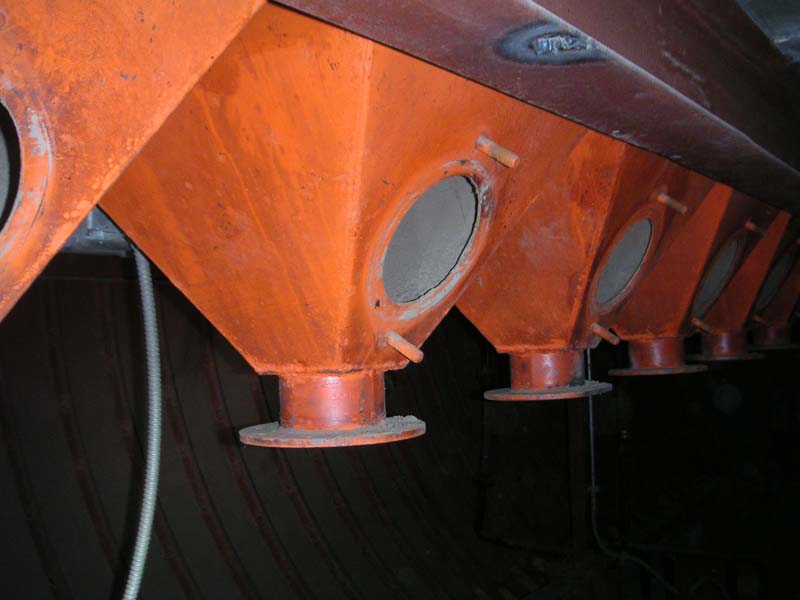
|
|
Dust
collection hoppers beneath the cyclonic dust separators.
Notice the access "portholes" for level
indication and maintenance.
|
|
The
hoppers were supplied with power during operation suggesting that their
functioning included some sort of auger to help settle the dirt into
the collection containers that had been attached to each one.
|
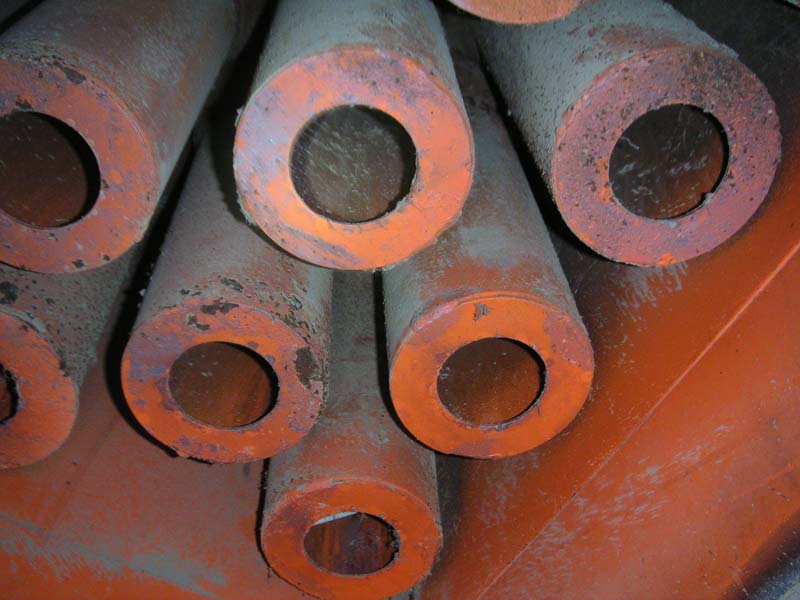
|
|
Cyclonic
dust separator tubes inside the collection hoppers.
|
|
The
cyclonic separators' functioning was very simple: as air swirled through
them, the heavier particulate and dust would eventually settle out
through the bottom of the tubes into the waiting hoppers. This
system filtered the air to an acceptable degree without employing
replaceable filters as the front line of defense against dust.
|
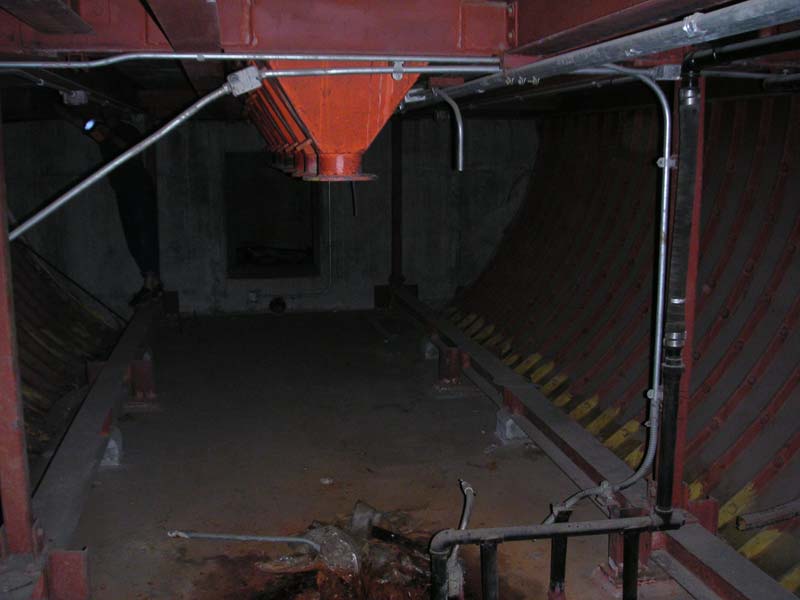
|
|
Lower
intake and filtration area, looking toward the entry
blast door.
|
|
It
is interesting to note that no more rigorous effort was made to filter
out radioactive dust from fallout by this or any other air intake system
of the Titan I missile complex. If an enemy missile sent fallout
blowing across the surface of a Titan I site it was coming right inside
the air intakes.
|
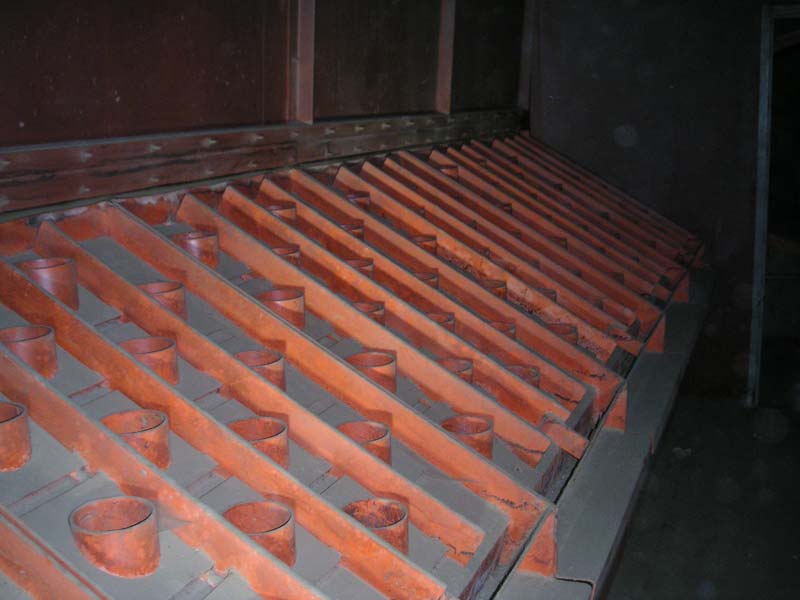
|
|
Top
of the cyclonic dust separators on the upper level of
the intake and filtration area. These tubes are
where the incoming air first enters this area after removal of dust and
other particulate.
|
|
Climbing
to the upper level of the filtration area, we found most of the
equipment had been taken; the fan had somehow been coaxed out of this
enclosed and rather constricted space. There is no way it was
removed completely in one piece so it must have been cut into chunks to
get it out of the way. The tunnels beyond contain little of value
so I have to wonder why they went through the trouble.
|
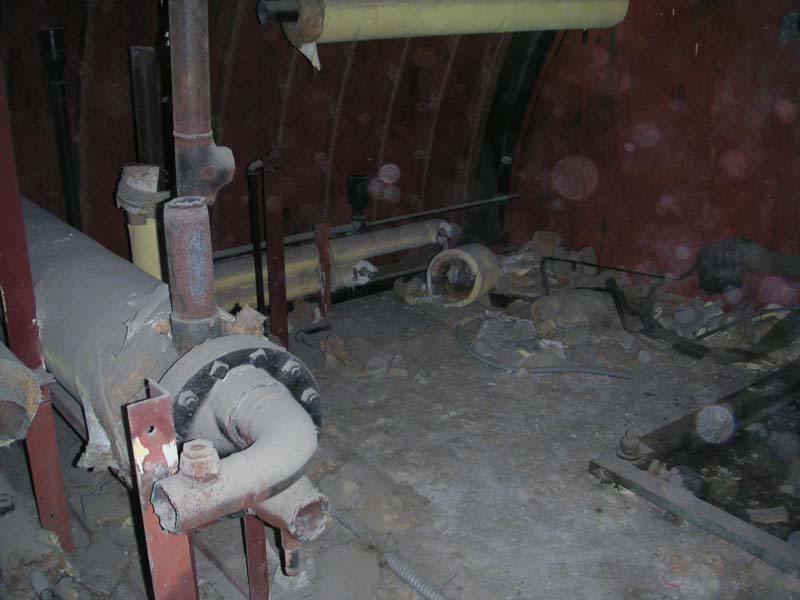
|
|
Plumbing
near the former location of the air intake fan (empty
brackets at right).
|
|
Ducking
into the air tunnels our backs groaned as we hunched over in the short
air shafts leading to the blast locks and launcher tunnels below.
|
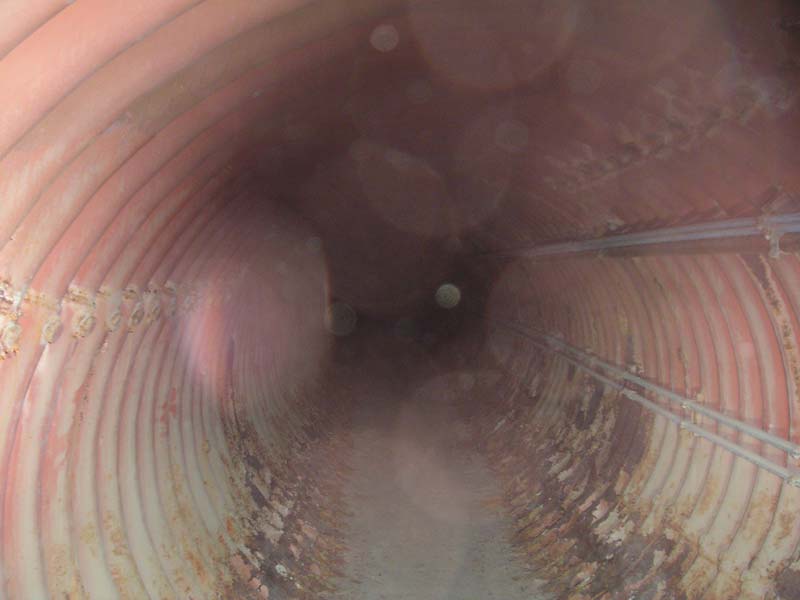
|
|
Launcher
area air filtration tunnels. These are 5' in
diameter requiring an uncomfortable crouch while
traversing them for all but the most diminutive of
visitors.
|
|
Ahead,
the tunnel branched off to both blast locks. We caught a quick
peek into the complex below through an open blast valve.
|
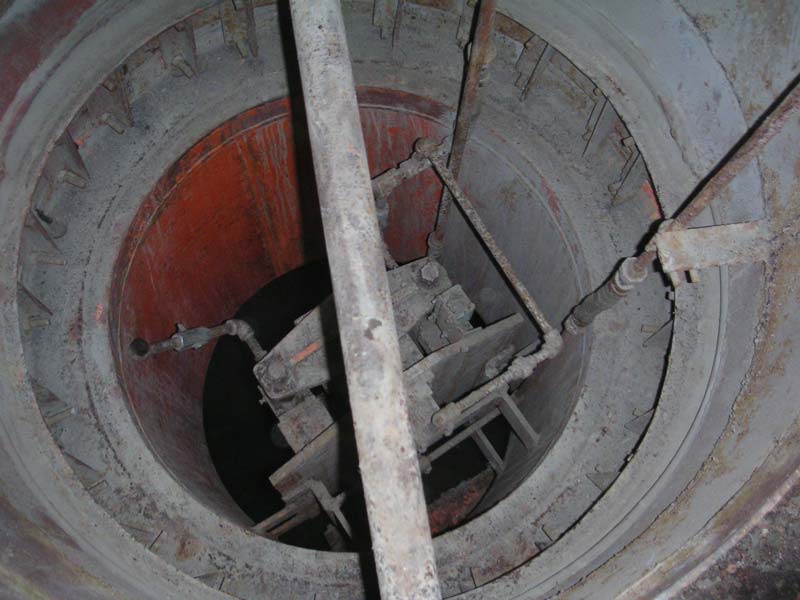
|
|
One of
the blast
valve shaft that supplied air to the launcher areas.
|
|
|
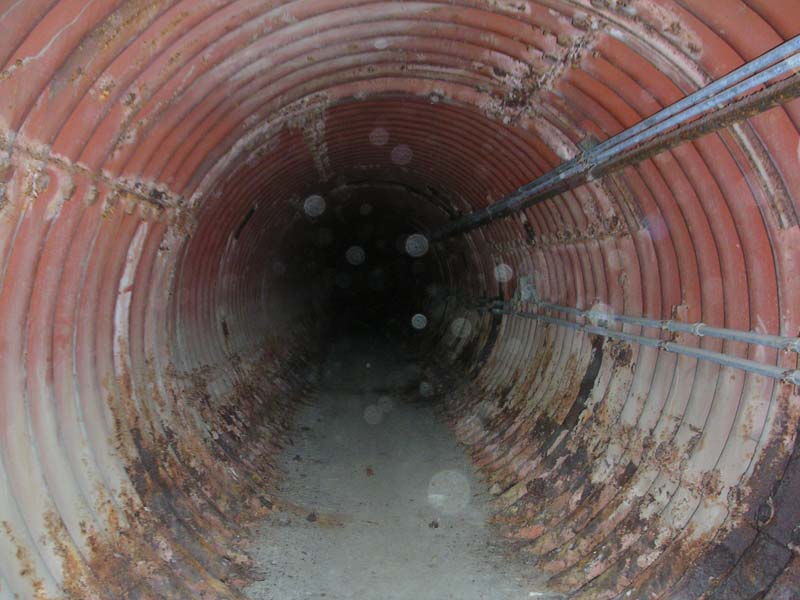
|
|
More
launcher area air filtration tunnels
|
|
Weary
from the uncomfortable tunnels, we eagerly headed back to the filtration
area and without much trouble from scuttling pigeons anxiously puttering
about, we emerged on the surface with daylight to spare.
|
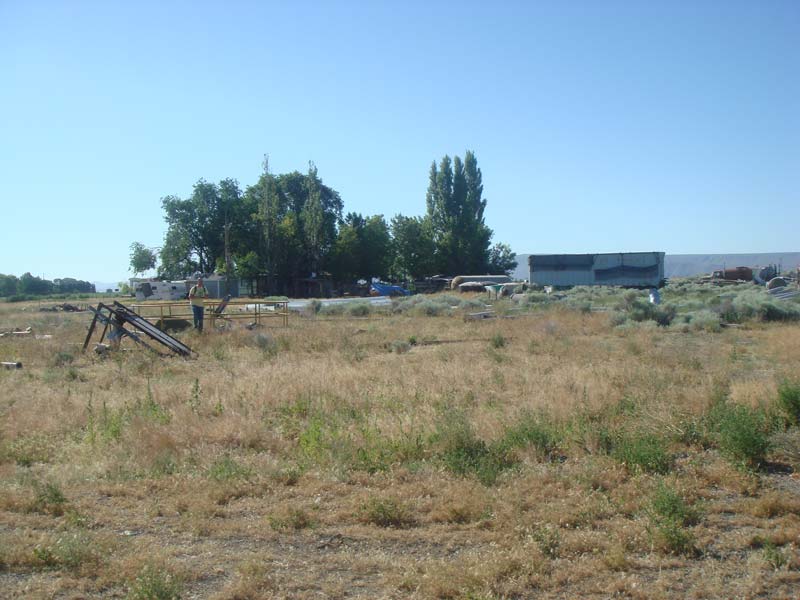
|
|
Looking
toward the power house air intake (left of center)
framed by junk, scrap and assorted, derelict vehicles
(and a few trees!).
|
|
Next
on the list of places to see was the power house air intake. At
first we tried to access it from inside the power house and went back
down to have a look. However, after assessing what could only be
described as an "extremely untrustworthy ladder" we decided to
approach it from the surface access.
|
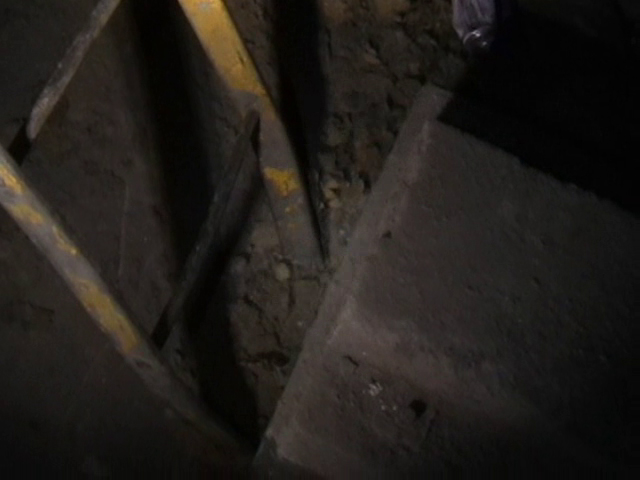
|
|
The
bottom of a very unsteady section of a long and very
damaged ladder in the power house. This led to the
air intake tunnel, but was so twisted and wobbly we
wisely abandoned any thoughts of climbing it.
|
|
We headed for the air
shaft and found it had been closed up in typical haphazard fashion using
steel and chain link fencing which at least would keep people and animals from
falling to the bottom, but not do much to keep determined intruders out.
|
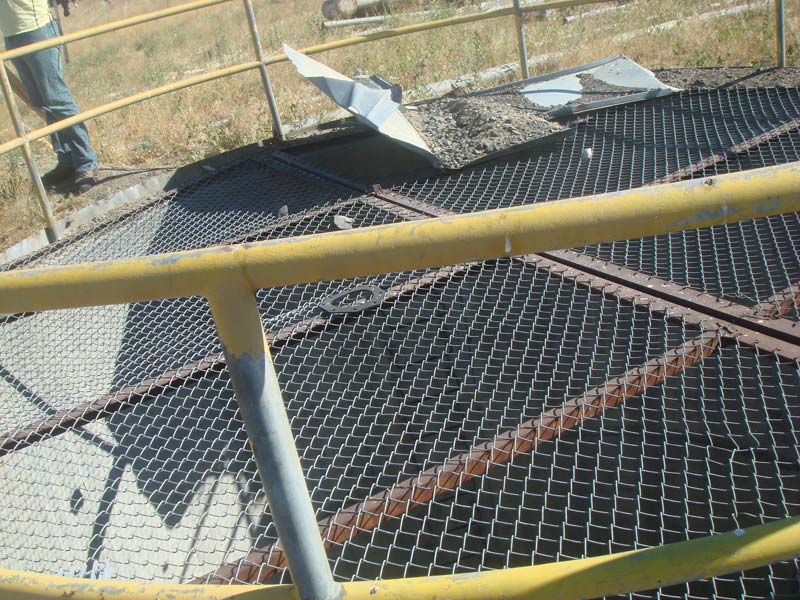
|
|
Power
house air intake shaft. Makeshift safety guard
provided by what appears to be scavenged steel and
cannibalized chain link from the perimeter fence (a
recurring strategy at several sites it seems).
|
|
Again
with the Pigeons
Another
great benefit of the shaft's closure was that it kept out the vile and
defiling nuisance of Columba livia,
if you'll recall from part 7-- the
common pigeon. With great displeasure I observed a gaping hole in
the safety and security once provided by the barrier over the
shaft. The pigeons, oh no, the pigeons! I thought.
Surely they had
infiltrated and befouled every square nanometer of space within!
I
was right.
|
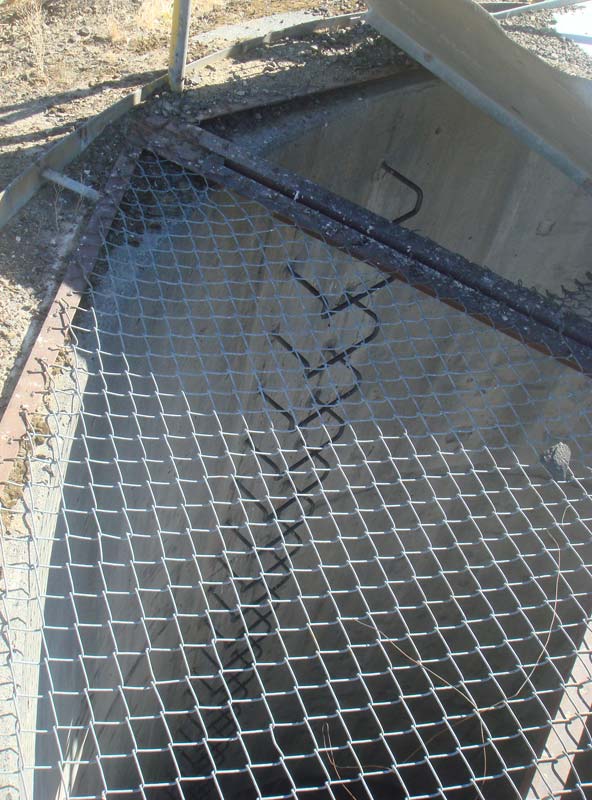
|
|
As
usual, things don't stay secured long at these
sites. Here, the maintenance access ladder has
been exposed and leads down into the site.
|
|
Looking
down the shaft I could see everywhere the evidence of their vile presence:
feathers and droppings were all over the place and the rungs of the
access ladder were encrusted with with the pigeons' odious calling
cards. I couldn't see the vile fiends, but their compulsive,
jabbering coos emanated unseen from them somewhere below.
It
was about this time that Walter, eyeing the ladder with its unwelcoming
strata of bird droppings, opted to bow out of further underground
incursions owing to the punishment inflicted on his back by a full day's
walking, climbing, kayaking, ducking and general physical
activity. A wise move perhaps; I would be on my own for this next
area.
The
Crappening
Before
I even started down I could see I was in for a treat. Apart from
the obvious and unavoidable filth on the ladder, (Gloves! If only I'd
brought gloves!) a far greater threat awaited me in the form of nervous pigeons
scuttling about below. A dreaded aerial assault loomed at the
slightest disturbance of those fine feathered fiends below.
I'd
barely begun my descent when one of the pestilent nitwits started
flapping about in circles threatening my as-yet fece-free hair and
clothing.
I
descended with prudent swiftness to a wasteland of trash and tires that
lay at the bottom where I became a veritable "fish in a
barrel" for possible bombardment-- hence, few photos were taken at
the bottom as I fled to relative safety (so I thought) through one of
the open blast valves.
The
images below are all video stills so the quality is poor, sorry.
|
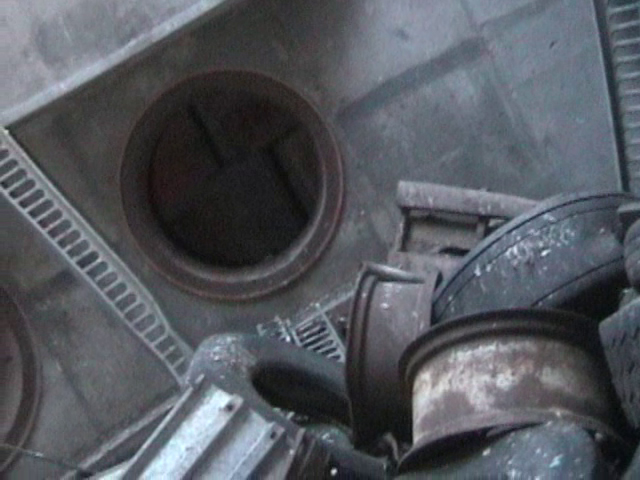
|
|
At
the bottom of the air intake shaft. Pigeon danger
is ever present! Must make it to safety!
There across this treacherous pile of junk I spied my
escape through an open blast valve.
|
|
|
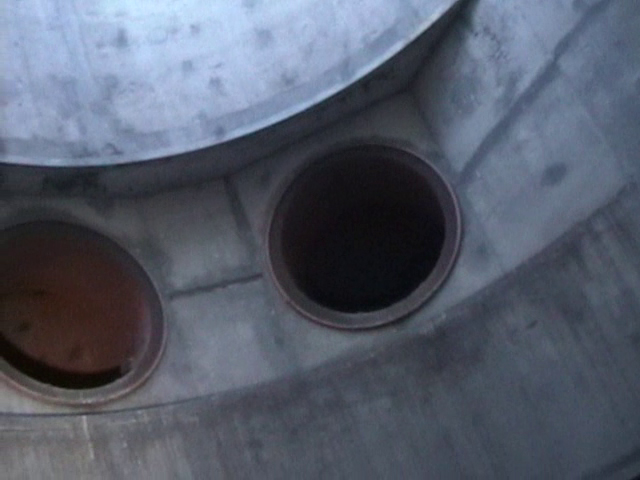
|
|
Upper
ring of open blast valves leading into the filtration
area behind about 2 feet of concrete.
|
|
|
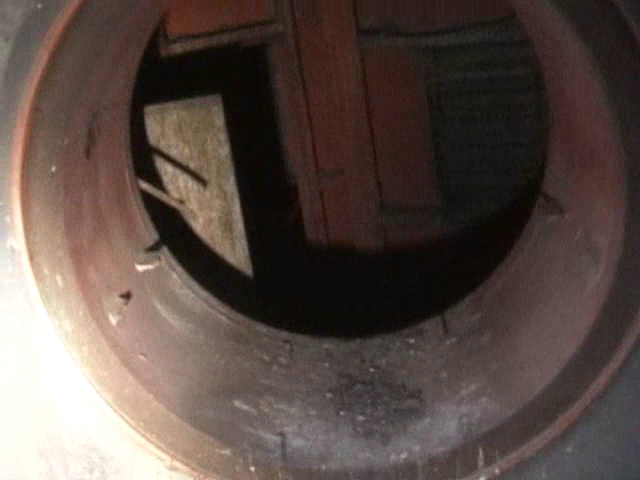
|
|
A
blast valve on the lower ring-- my ingress
|
|
Piled
high
Amidst
the precarious and highly unstable footing, I struggled to close the
distance between myself and what I then perceived to be safety.
Crossing the debris field of tires, metal and wildly pitching junk, I
struggled hard to keep my footing and escape the pigeons which,
disturbed by my sudden appearance, flew about stupidly over my head
filling me with great unease.
|
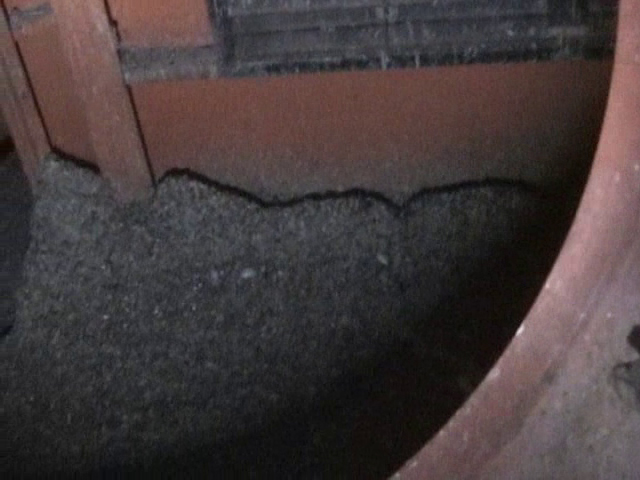
|
|
A
horror show of pigeon waste awaited me inside the
filtration area. This was only just a peek at the
unspeakable sights and smells I would experience.
|
|
When
I reached the wall of the shaft, I was faced with an opening that was
lined with bird droppings. The sound of many birds could be heard
within; if I went inside, would I be moving from the pan to the fire?
Taking
care not to grab the filthy ledge, I pulled myself up into the opening
and then observed the horror that lay within: incredible and revolting
mounds of accumulated bird droppings-- decades worth-- covered the
interior. The air was thick with dust and bits of pigeon feathers
and I shuddered to think of what that dust was chiefly comprised of as
visions of histoplasmosis* danced in my head.
*
An often flu-like lung disease caused
by fungus present in soil, bat and bird droppings. Histoplasmosis
impairs lung function (among many other symptoms) and can be fatal.
|
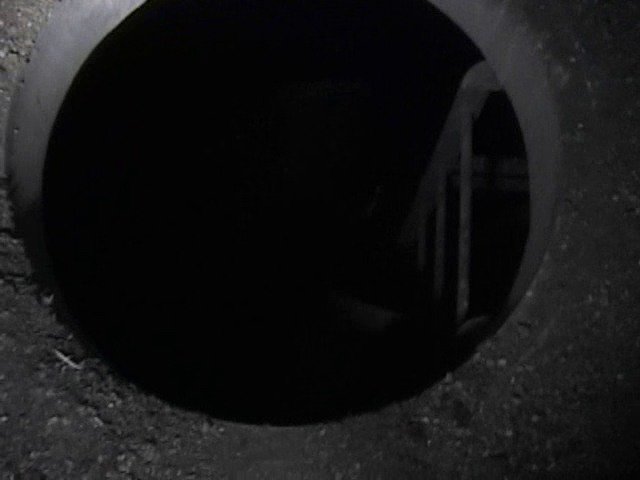
|
|
Access
to the lower level dust collection area-- an absolutely
frightening swamp of putrid black mud and water filled
with decaying bird corpses, mold, feces and feathers.
An absolute nightmare. I dared not tread there.
|
|
Passing
through the open blast valve I dropped down onto a thick covering of
bird excrement-- an accumulation of decades' worth of it-- layered over
with the bones and feathers of many, Many, MANY pigeons long since
deceased.
|
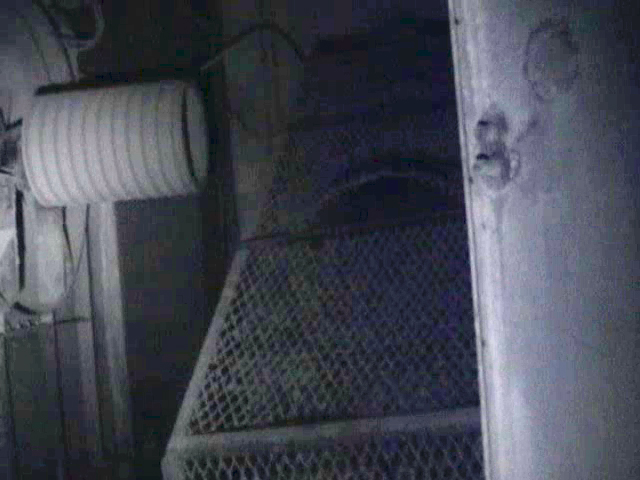
|
|
Air
intake fan sheaves (the pulley where the belts go) at
left and a gigantic belt guard that used to cover them.
|
|
The
air was thick and filled with roiling dust continuously agitated by nervous,
scuttling, feathered, vermin that fluttered about chaotically trying to
escape my approach. The reek of decay and ammonia fell upon me
like a moldy, wet towel making me unconsciously breathe as little as possible.
|
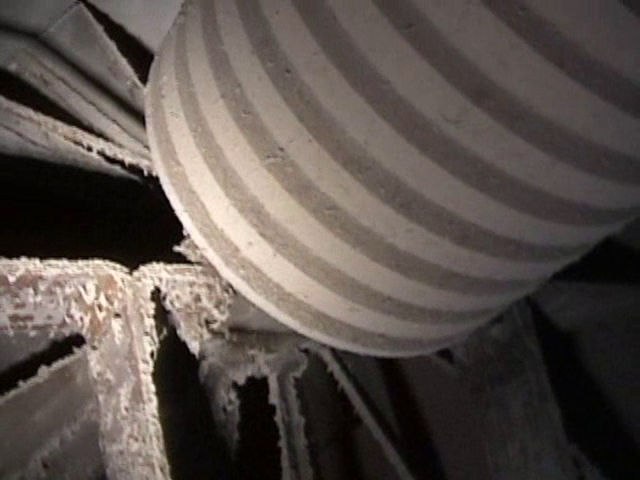
|
|
I
have never seen another fan with this many drive
belts! This thing was huge! This one takes
10 belts!
|
|
Conscious
of the perilous nature of the air, I drew fewer and shallower breaths,
and-- in a futile effort to perhaps spare my lungs-- breathed only
through my tortured nose.
I
found myself in a space between the blast valves and the intakes to the
many dust collectors. This space was cackling with hidden pigeons,
any of which could take flight at any moment and unload on me like I was
an
old Chevy.
|
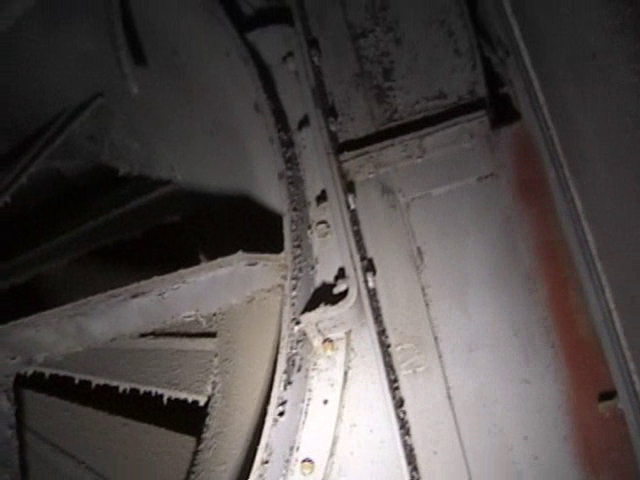
|
|
Variable
inlet vanes on the air intake fan. Yup, this baby
was manufactured by Trane Co. in LaCrosse Wisconsin and
shipped cross-country by rail just like those at the
Lowry site, and, I'm guessing, ALL the Titan I
sites.
|
|
Quickly
I headed through a narrow access door into the exit side of the dust
collectors, where, amazingly, conditions deteriorated even further: more
passed-on pigeons were strewn about and the dung covering the floor grew
ever deeper!
|
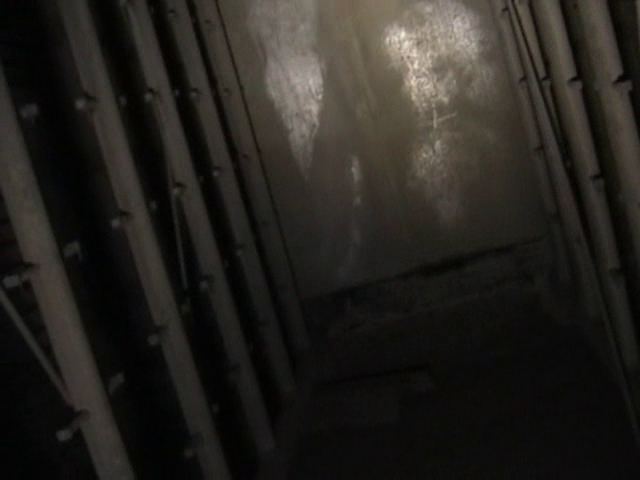
|
|
Spray
nozzles inside the air intake air washer. This
system performed several functions: removing dust and
raising or lowering humidity and temperature of the
incoming air. A mist of chilled water was sprayed
into the air as it passed through this area.
|
|
I
couldn't help thinking how Walter was probably enjoying a leisurely walk
about the surface while I blundered further and further into a nightmare
of filth and decay while clouds of infectious miasma swirled about me.
|
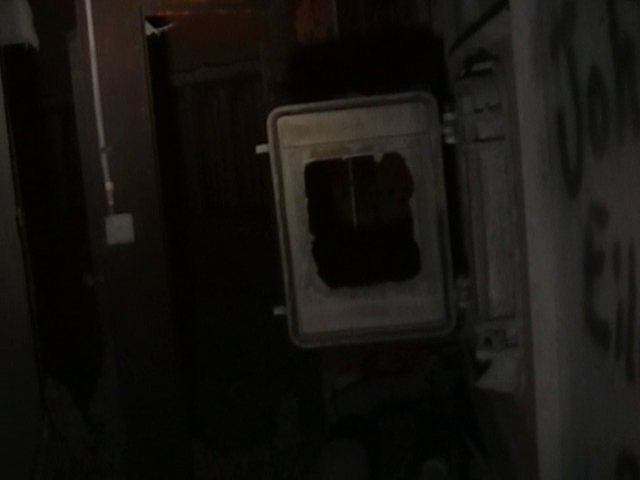
|
|
An
access
panel into the air washer with the glass broken out of
it. We can't have nice things!
|
|
|
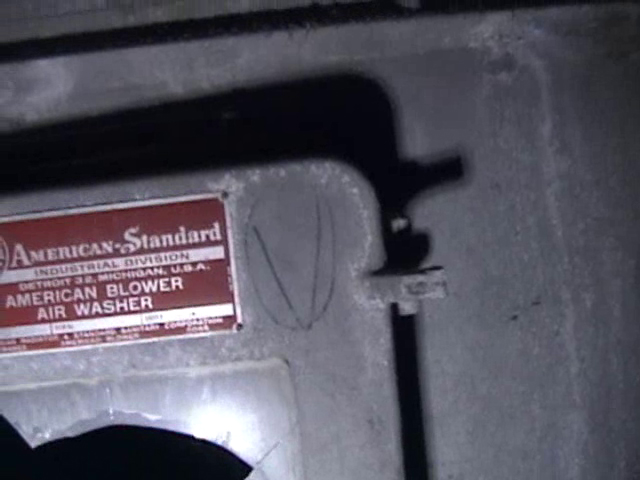
|
|
It
washes... It blows...
American
Standard: Not just toilets and urinals anymore!
|
|
|
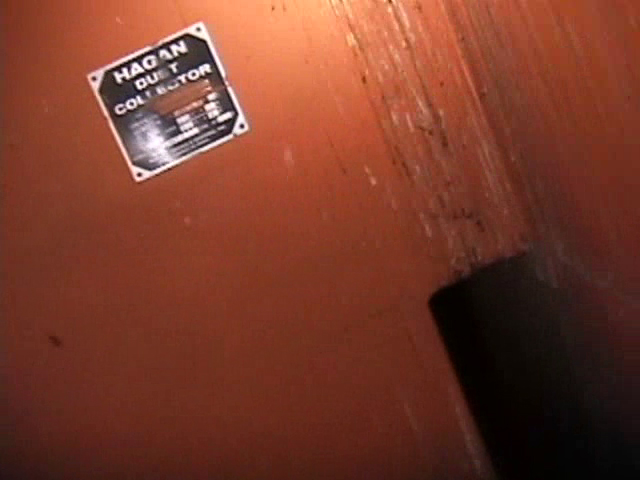
|
|
Tag
on the side of the cyclonic dust separators. Banks
of these truck-sized collectors surrounded the air shaft
helping to filter all incoming air.
|
|
|
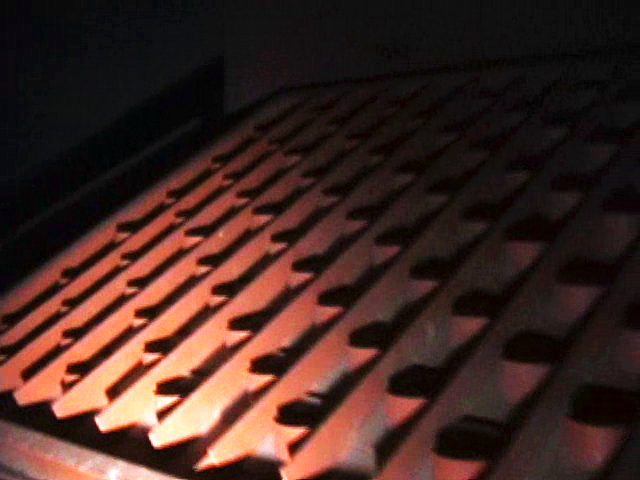
|
|
Top
of a dust collector showing the outlet tubes where air
exited before heading on to the air washers.
|
|
Determined
to see everything, I spent as much time looking about as I could
stand. Once I moved away from the dust collectors, the pigeons and
their attendant and abhorrent filth lessened somewhat. I spent a
bit more time looking at the air intake tunnel and fan before braving
the ladder back to the surface. On the way back up soiling by
pigeons was averted, but my hands were seriously defiled by climbing
that nasty ladder!
|
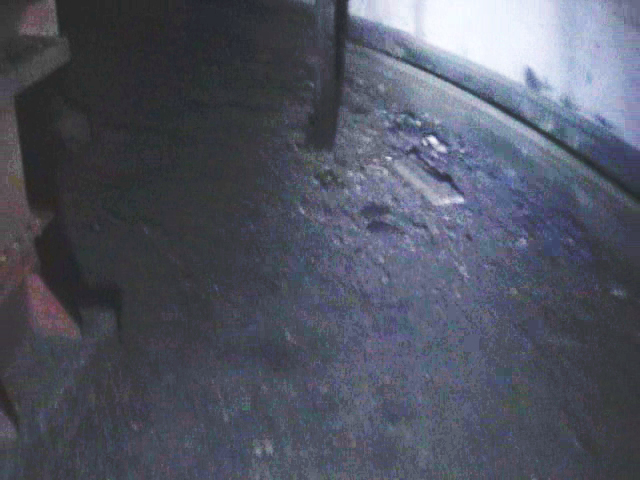
|
|
The
incredibly filthy floor in the air intake. A dust
collector stands at left.
|
|
|
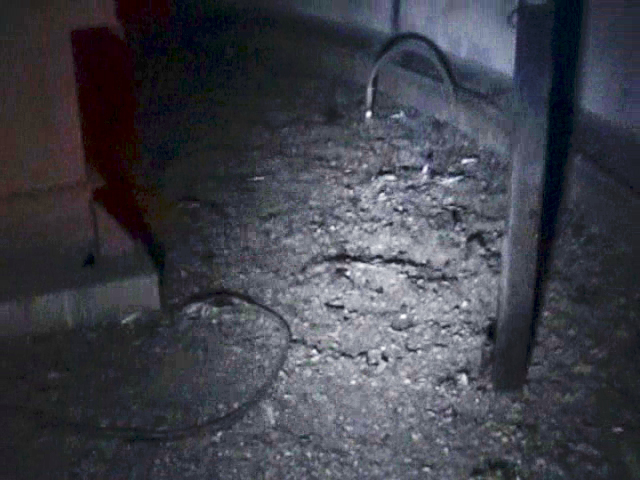
|
|
A
closer look at the unbelievable retch-inducing
conditions in the power house air intake facility. The
floor is covered in droppings several inches deep and
littered with feathers and uncountable carcasses of dead
pigeons. You will never find a more wretched hive
of scum and pigeonry (actually, yes you will. Read
on below.).
|
|
|
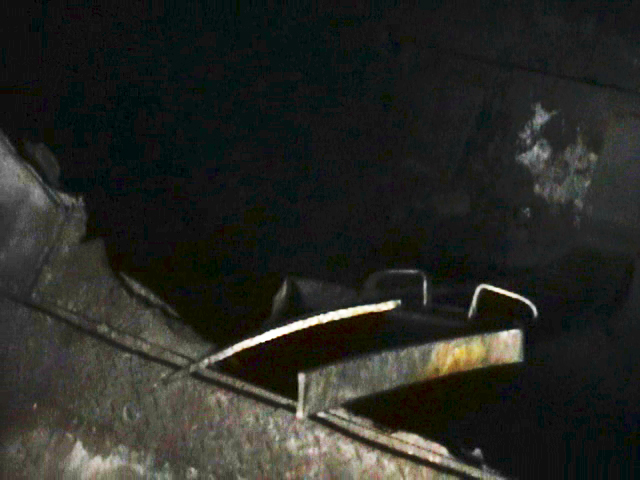
|
|
Looking
down into the power house from the air intake tunnel at
the rickety deathtrap of a ladder connecting the
tunnel to the unyielding concrete of the floor 16 feet
below.
|
|
Back
on the surface again, I gratefully gulped the clean air and counted
myself lucky that the only bird droppings I'd accumulated were from the
rungs of the ladder.
I
fully planned to forge onward and see the power house exhaust and thus
complete my exploration of 568-C. Having witnessed the hazards
presented by the pigeons at the air intake and hearing my tales of
revulsion and disgust about the conditions therein, it came as no
surprise that Walter also opted out of visiting the power house air exhaust.
The
Titans'
Curse
We
found the exhaust shaft to be completely open at the top, save for some
supporting steel that had been welded in place to support a cover or
barrier of some improvised sort.
I
groaned at the implications of this open shaft, knowing that it would
certainly mean a plague far greater than the last one awaited me
below. A continuous babble rose from somewhere down within the
complex hinting at the menace harbored there.
Sure
enough, as soon as I started down the ladder a couple of the rotten
bastards took to the air; flying about like idiots, they seemed unable
to find the huge exit overhead as they flew in circles.
Walter
did his best to shoo them away from the ladder, but it was no use, I was
brutally soiled well before I reached the bottom and dove for cover.
The Titans had exacted their vengeance on me for my intrusion.
|
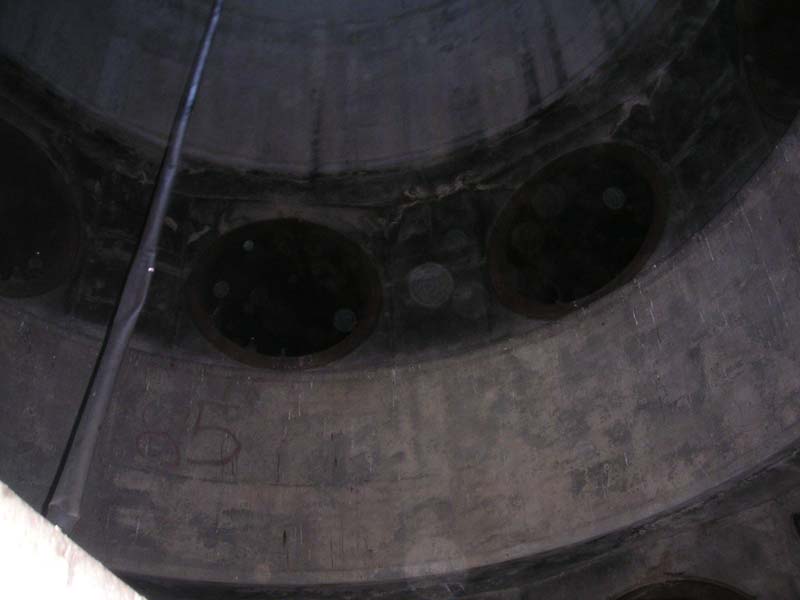
|
|
Upper
row of blast valves at the power house exhaust.
|
|
Inside
I found myself in even greater peril as I flushed out more of the bloody
birds from their hiding places. My supposed "refuge"
turned out to be a nightmare of flying, noisy, excreting peril.
The
air was much much worse than before and thick with dust and
feathers. Birds blundered about everywhere, taking flight and
stirring up the filthy air even more. The stench was astoundingly
vile and ammonia burned my nose. Dead birds and egg shells were
everywhere atop a much deeper layer of accumulated pigeon waste.
My
camera, nearly useless in the clouds of dust, was quickly abandoned to my
pocket. Any photos I tried to take in that place would only show a
kaleidoscope of dust motes rendering the image as thousands of white
speckles.
|
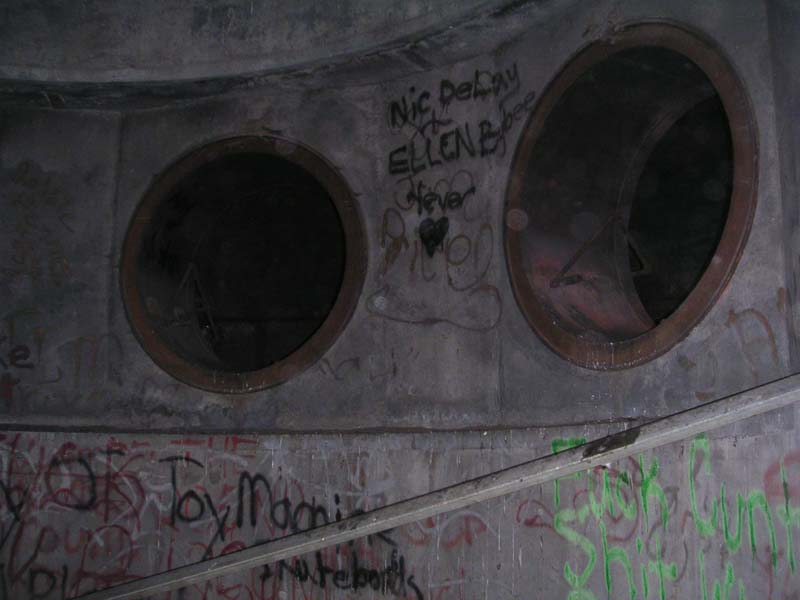
|
|
Lower
row of blast valves, left wide open for maximum pigeon
infiltration and aggravation.
|
|
I
spent only seconds in the area and headed directly toward the exhaust
tunnel in hopes of escaping some of the birds and odor that tortured me
near the blast valves.
Putting
some distance between myself and the blast valves did provide some
relief from the pigeons, but by that time I had already taken several
hits. The passage followed the curvature of the wall to the former
location of the exhaust fans. There I encountered a troubling
obstacle.
|
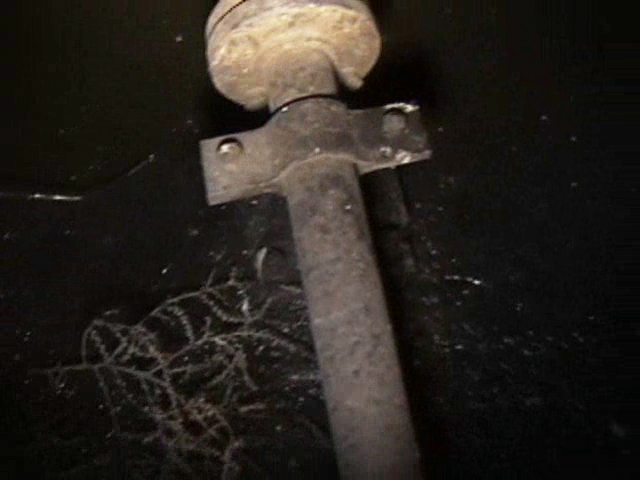
|
|
This
pipe appears to be solidly mounted to a concrete floor,
but how much floor surrounds it?
|
|
Water
had collected at the mouth of the exhaust tunnel that led into the
complex. It appeared to be mere fractions of an inch deep owing to
nearby landmarks, but the dark, crusted and foul muck made it impossible
to tell if I would be stepping on solid ground or if I would dunk myself
in some of the most unearthly effluent I'd ever encountered.
A
couple narrow pipes enticed me to test my balance and tiptoe across on
them. I decided against that idea after very little consideration.
|
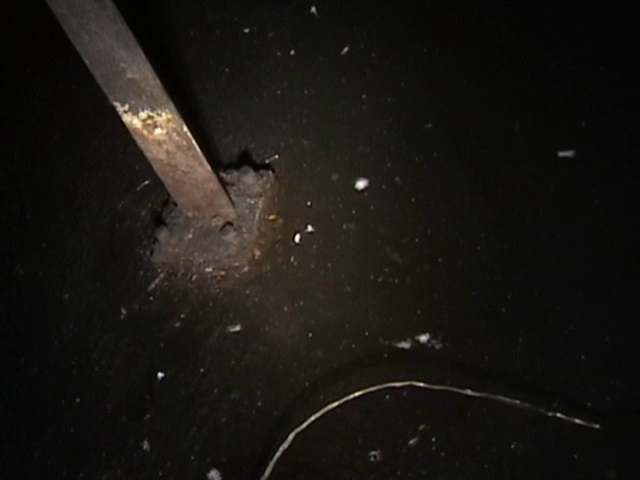
|
|
There's
just got to be a floor under there right? Look, a
steel support. It should be fine to step near that
right? Right??
|
|
It
looked like water, it really did-- disgusting, black, filthy
water. I sensed a trap.
As
if to allay my suspicions, a pigeon waddled moronically about the area, demonstrating, it seemed, that all was well and the ground was
solid. Go ahead, take a step, it seemed to say.
|
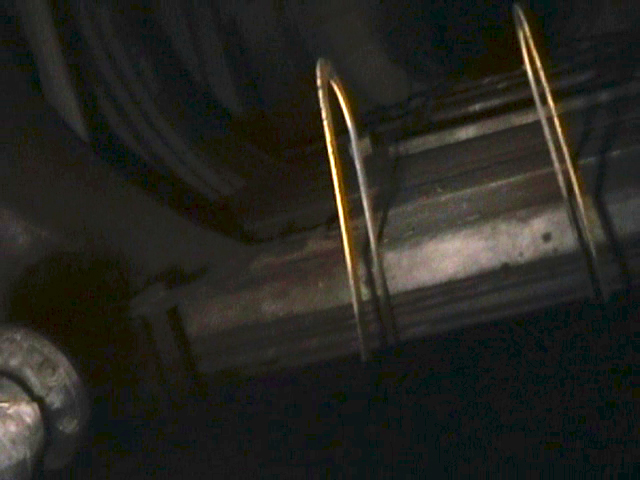
|
|
Across
the void, the exhaust tunnel calls with promises of
intrigue and solid footing with no pigeons. I had
only to walk over and climb a short ladder.
|
|
I
looked around for anything I might use to test the surface: a twig, a
pebble, a contrabassoon-- anything, but somehow in that ravaged and
littered place there was nothing that really fit the bill. Nothing
I would touch anyway. I wasn't about to pick up a dead (or living)
pigeon.
The
exhaust tunnel beckoned from across the short expanse of dubious ground
as I hesitated.
I finally put one foot out and tested a spot, encrusting my shoe with
black mud as it touched down on concrete. It was safe!
This
is how it gets you, I thought. If I let down my guard at any
point and neglect to test a spot, that's when I'll fall right in.
Making
my weary way carefully to the ladder, I arrived without incident to find
that the ladder itself was partially submerged in a water-filled
gap I could easily have blundered into had I not been cautious.
|
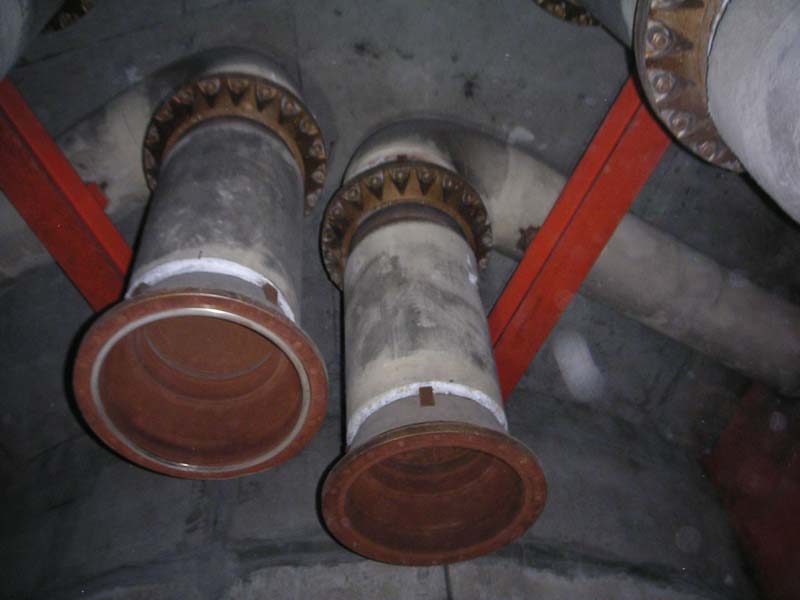
|
|
Diesel
exhaust lines near the exhaust tunnel. All that
insulation is asbestos plaster. Most of it is in
good shape, but some damage and erosion is evident
making this a potentially hazardous area.
|
|
|
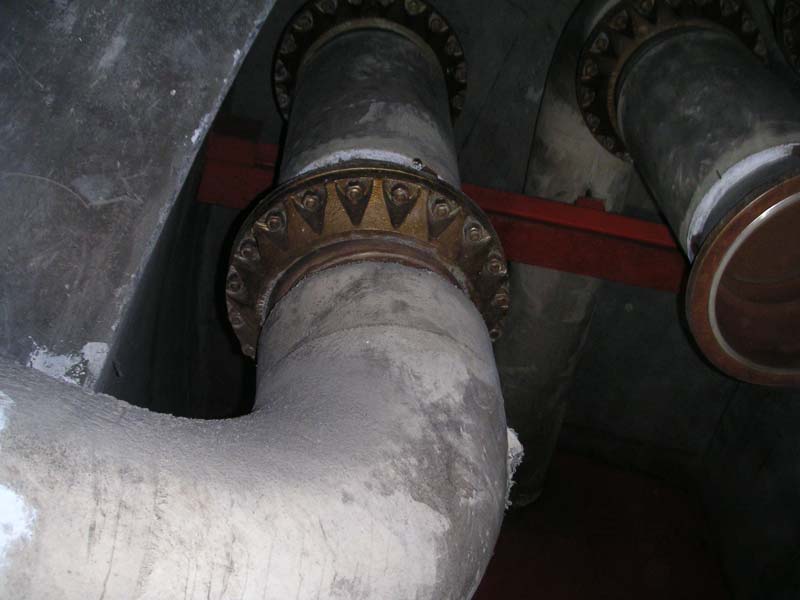
|
|
These
exhaust lines are about 2 feet in diameter and are
joined by huge cast flanges (bronze colored). Some
damage to the asbestos plaster is visible on this elbow.
|
|
|
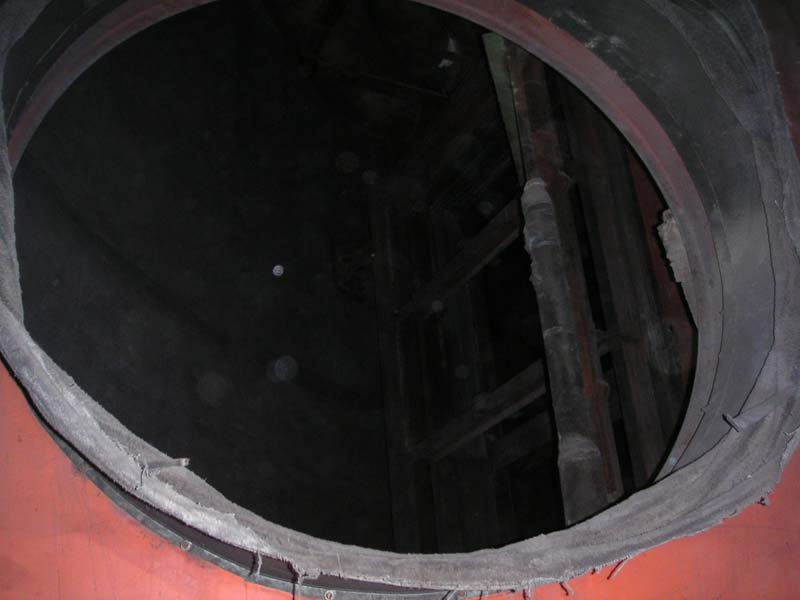
|
|
One
of 2 large exhaust fans used to be mated to this opening
to force effluent out through the blast valves deeper
inside the exhaust facility.
|
|
|
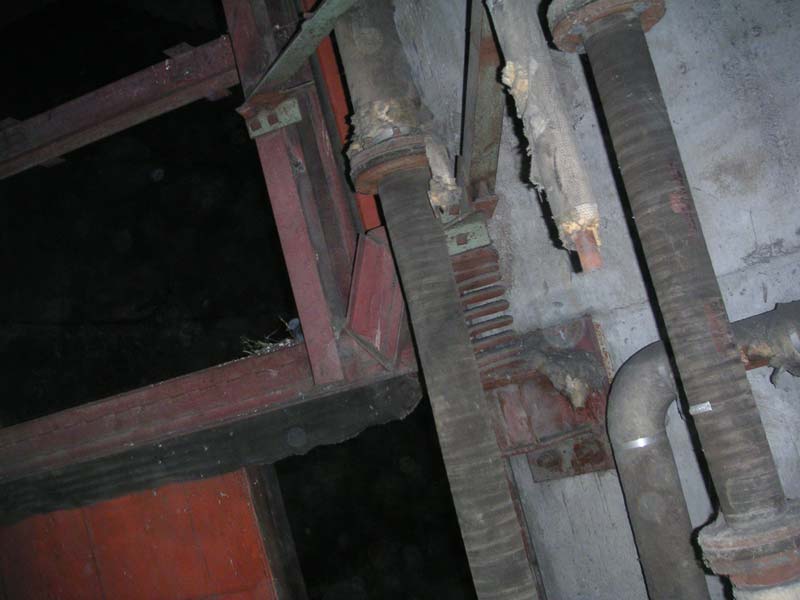
|
|
Shock
mounted frames and plumbing at the outer plenum.
This area is still behind the blast valves. I have
no idea what used to be mounted to the large steel
framework, but I suspect it may have been dampers to
control airflow. As for the plumbing, I have no
idea why water service would be present in the exhaust
facility. Any insight would be welcome.
|
|
|
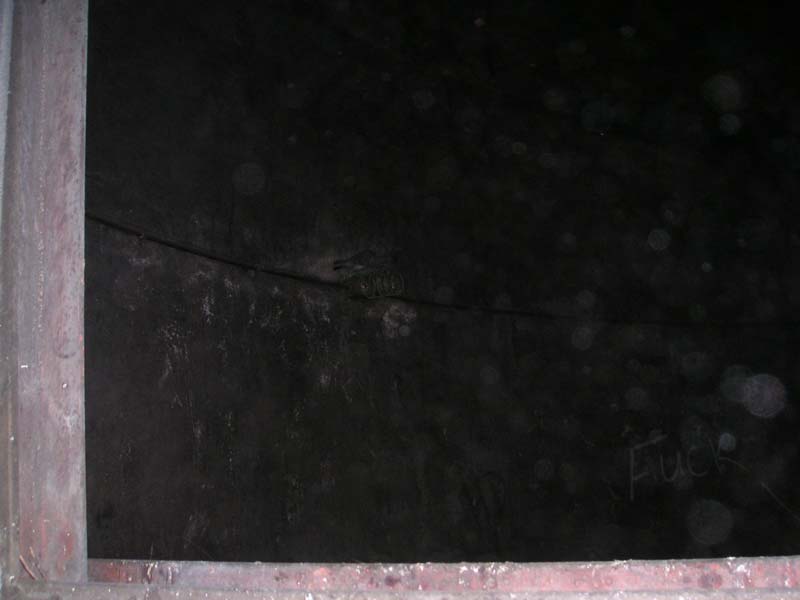
|
|
Exhaust
plenum past the fan bulkhead. Of course there is a
pigeon on that light fixture.
|
|
|
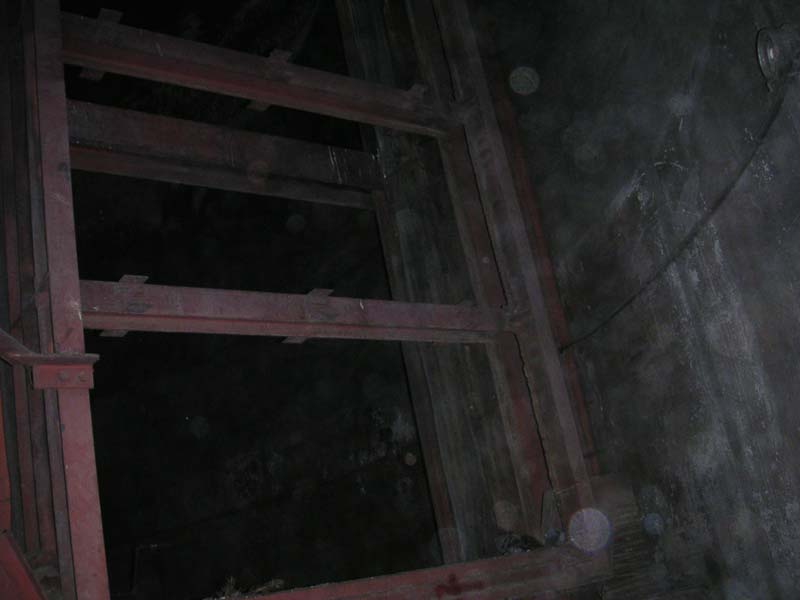
|
|
The
mysterious frame for which I could not determine its
function. With pigeons infesting it of course.
|
|
|
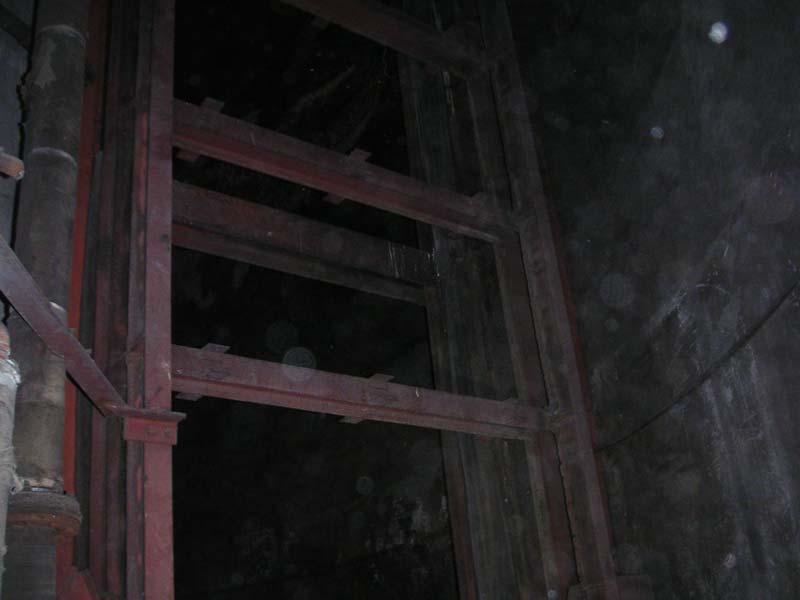
|
|
Another
shot of the shock mounted frame with plumbing running
along one side. What are those pipes for?
|
|
|
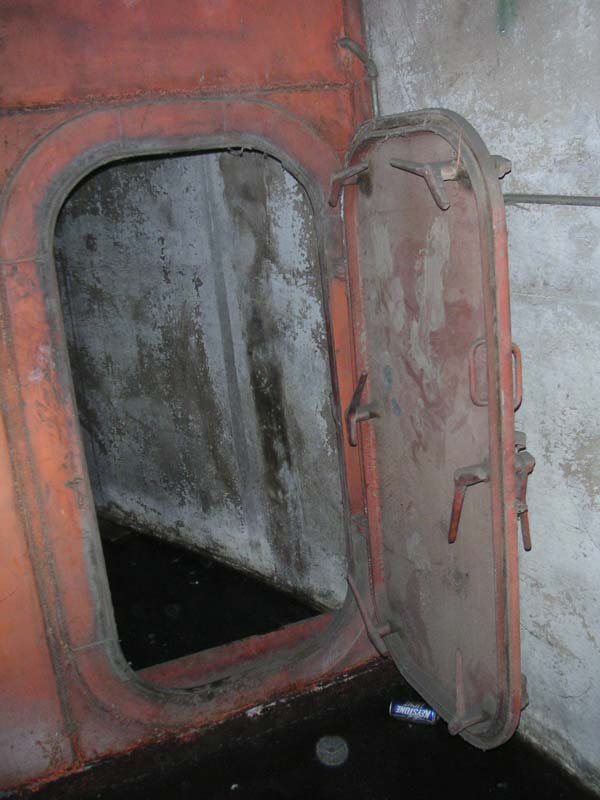
|
|
Ship-style
water/air-tight port door in the fan bulkhead.
This door needed to seal well to both withstand and
maintain the positive pressure on the other side when
closed. That pressure is what forced the exhaust
out of the facility.
|
|
Though
the ladder did pitch in a bit of a threatening gesture, I arrived safely
in the asbestos-laden exhaust tunnel. In truth, it appeared that a
good job was done in removing the majority of the asbestos in the
exhaust tunnel, but a lot of residue remained-- especially under the
floor panels.
|
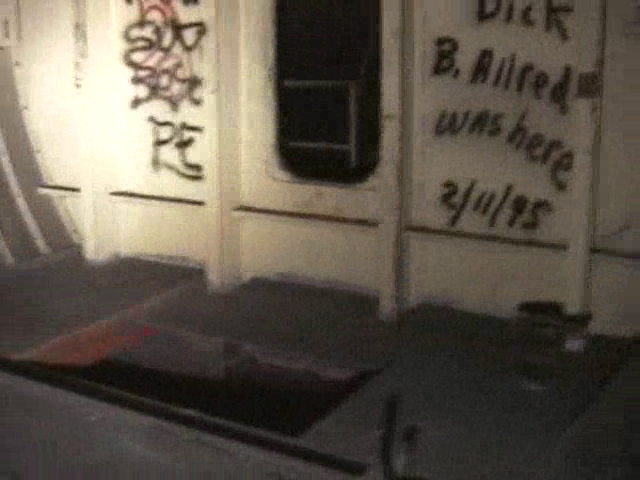
|
|
Bulkhead
leading to one of the 3 diesel tanks in the exhaust
tunnel.
|
|
Looking
in at the fuel tanks, I couldn't get my lousy camera to focus in the low
light of the large storage room combined with the matte black of the
fuel tank.
The
smaller tank was easier work with and as I looked in, I noticed that
there was no mention of the tanks ever having been emptied or cleaned as
they had at Lowry 724-C. The scent of diesel was very strong and I
wondered if there might still be fuel in those tanks.
|
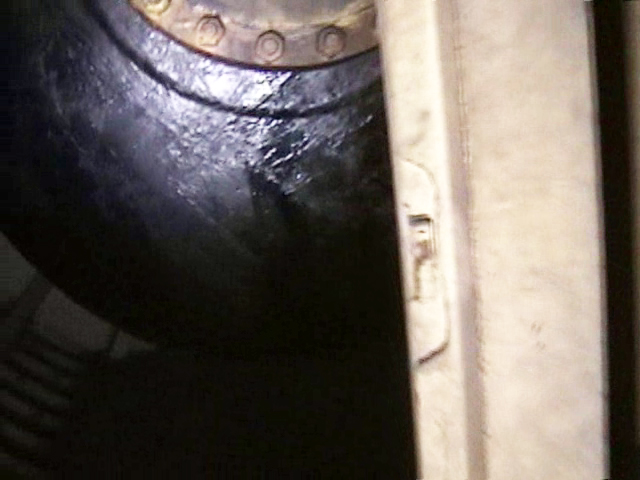
|
|
Peeking
in at the 5000-gallon day tank in its storage
area. The smell of diesel was very strong in this
area.
|
|
|
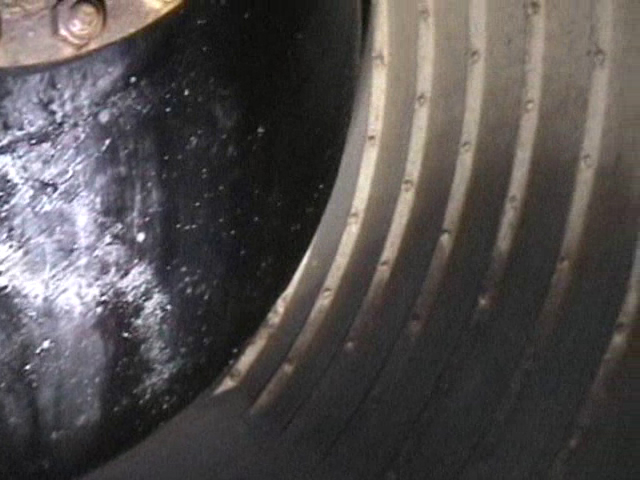
|
|
Looking
around the enclosure. The tank has a tar or rubber
covering to prevent corrosion. The diesel smell
was getting worse.
|
|
After
observing the fill and vent lines leading to the tank, I noticed
something a bit unsettling as it appeared as though diesel fuel was
actively leaking down the wall by the day tank. One entire space
between joins in the tunnel liner was black with diesel fuel that had
run down.
|
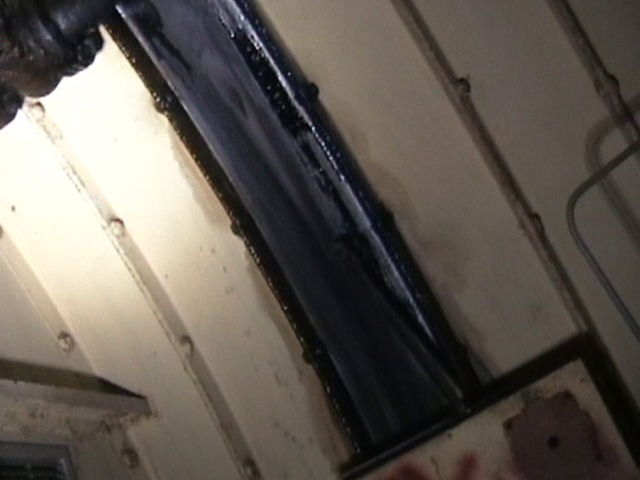
|
|
The
reason for the fuel stench: actively leaking diesel fuel
at the day tank.
|
|
At
the time, I had no idea how the hell a tank with residual fuel could
leak like that. Clearly there was not a hole in the tank, rather
the fuel was leaking around a failed gasket at a pipe flange and from
farther up along the line somewhere. Any remaining fuel sitting in
the bottom of the tank cannot just flow up the fill pipe and find its
way out of a leak higher up. Gravity would surely take issue with
such a feat. What was going on here?
|
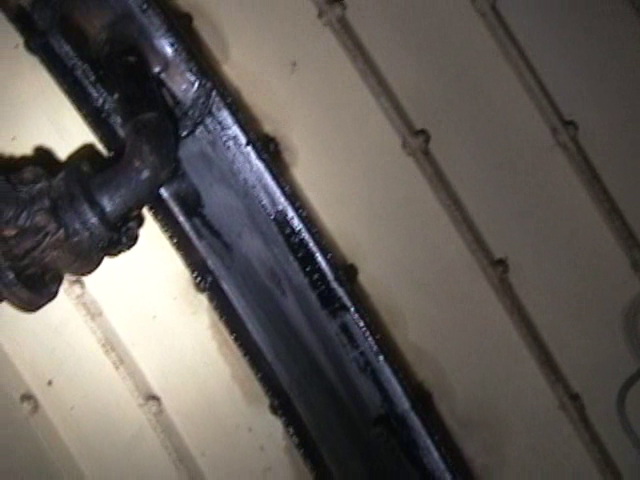
|
|
A
leaky pipe flange with rags wrapped around it at the day
tank.
|
|
One likely way this happened comes from a typical
condition that commonly occurs in all underground storage tanks.
Atmospheric moisture always condenses inside a tank over time where it
runs down into the fuel and pools at the bottom because diesel floats on
water (as do other fuels). Over time, the level in the tank rises
owing to this accumulation of water in the bottom (it is common practice
to have this water removed in an actively used tank) and the diesel
fuel, being on top, was the first thing to find its way up and out of the vent
or hole or failed gasket when the level became high enough.
|
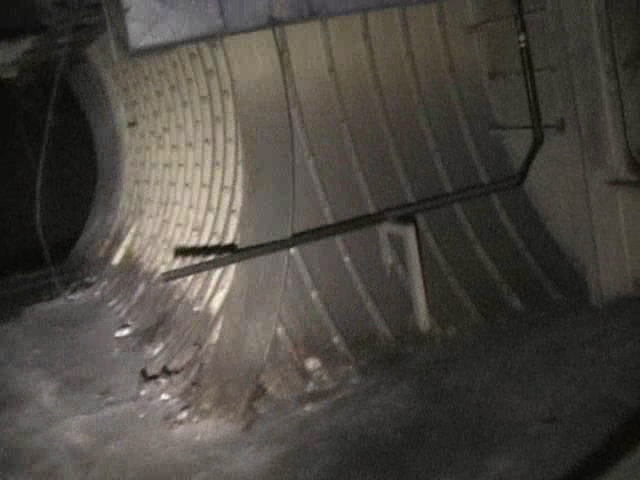
|
|
Exhaust
tunnel leading to the power house at left. Day
tank fuel storage bulkhead is on the right.
|
|
Following
my discovery of leaking petrochemicals, I quickly made a somewhat
cursory look around the rest of the exhaust tunnel and climbed the hell
on up out of that disgusting place.
|
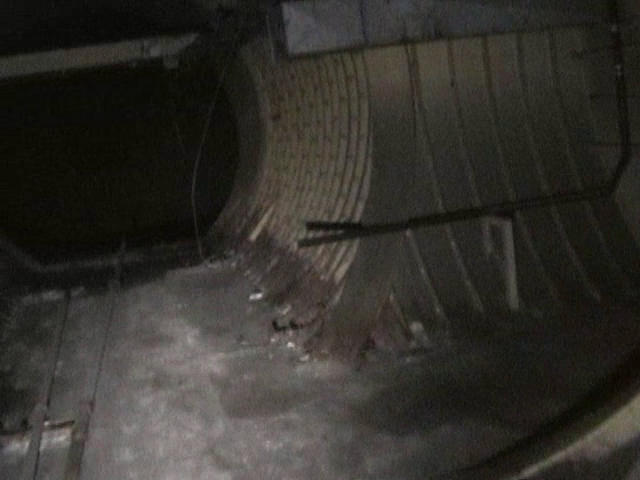
|
|
Heading
toward the power house. Normally this tunnel would
bring you to the mezzanine level but alas, the entire
mezzanine has been torn out leaving a pleasant 16 foot
drop to the concrete floor.
|
|
|
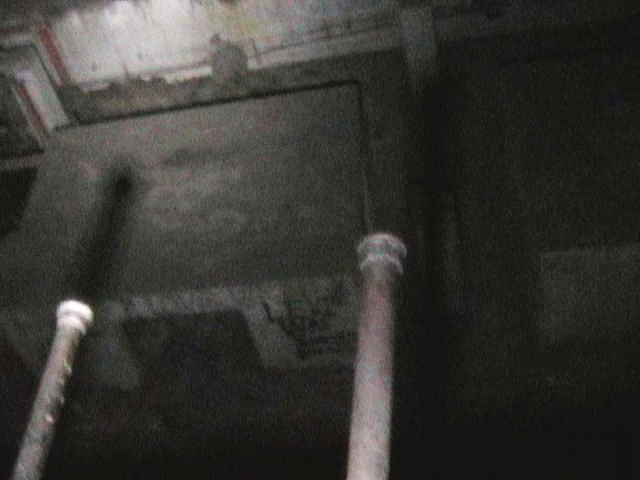
|
|
Looking
down into the power house at the many slabs and open
trenches below.
|
|

